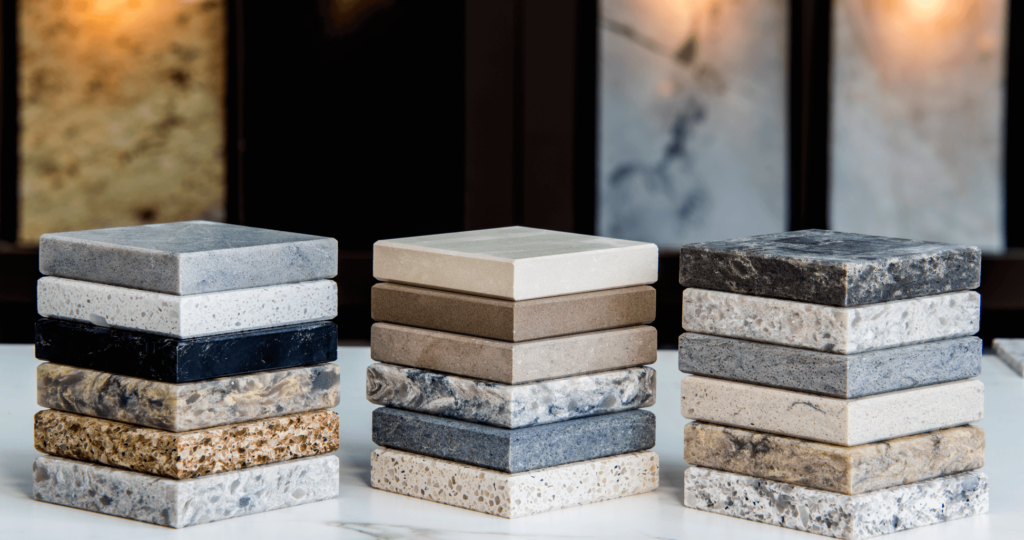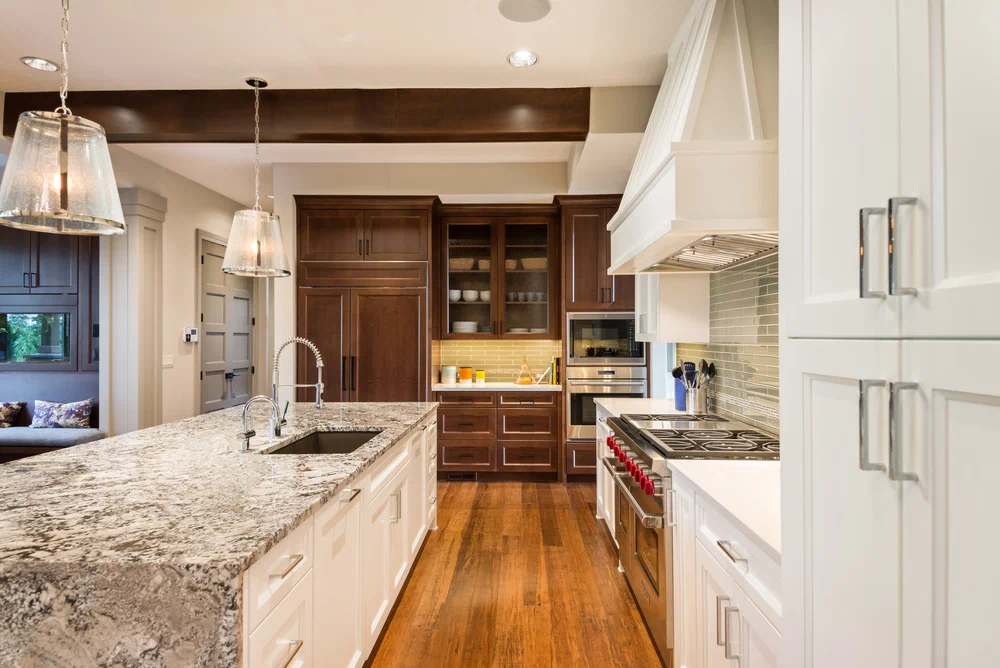Exploring Popular Countertop Materials: Granite, Quartz, Marble, and Butcher Block
Countertops are essential elements in kitchens and bathrooms, playing a key role in both functionality and design. Popular countertop materials range from classic natural stones like granite and marble to modern engineered options like quartz. More than just flat surfaces, countertops serve as spaces for meal prep, storage, and a reflection of personal style. Choosing the best countertop materials are an important decisions that impacts usability, aesthetics, and even your home’s value.

Popular Countertop Materials and Their Pros & Cons
1) Granite
Manufactured Granite countertops are one of the most used countertops. Granite is a type of natural stone that is characterized by the availability of a vast number of variations in color and pattern combinations, thus making each slab unique.
Pros of Granite
- Durability: It is highly resistant to scratches and to heat.
- Unique Patterns: Ideally, each piece of granite is going to be different from one another.
- Increases Property Value: Granite provides a luxurious appearance to any home.
Cons of Granite
- Requires Regular Sealing: Granites are porous materials and after some time they require resealing.
- Heavy: It can be difficult to be mounted onto any other surface.
- Expensive: It is relatively expensive among all countertops available in the market.
Granite Countertop Installation
Granite countertops are placed in stages, and they need to be prepared very carefully and accurately. First of all, you have to measure your space to know the exact dimensions of the countertop needed. Granite slabs are generally cut with diamond-tipped saws. The granite slab is then placed efficiently in the cabinet. Sometimes adhesives are incorporated to provide additional strength. It is important because the countertop needs to be leveled precisely to sit flat on the surfaces. Precision leveling is the final step before the granite is polished and sealed to prevent it from getting stained or damaged in any way that would also improve the look.
2) Quartz
Quartz has gained popularity in use since it is easy to maintain because of its non-porous polished surface that does not accommodate bacteria. Quartz comes in uniform pre-set patterns and colors.
Pros of Quartz
- Low Maintenance: There is no need for sealing time and again.
- Variety of Designs: This is produced in different styles and designs.
- Long-Lasting: Quartz sand is designed to be rigorously used for daily applications.
Cons of Quartz
- Heat Sensitive: Quartz has the worst advantage in that it is sensitive to high temperature, it can even be destroyed by heat.
- Not Fully Natural: Some homeowners have a natural stone kind of preference.
- Cost: Quartz can be expensive.
Quartz Countertop Installation
Quartz countertops installation can be done in the following way.
The first step is to take measurements of the space it will cover to fit it correctly on the countertop. The second step involves preparing the surface of the area by strengthening cabinets to be able to support the weight of quartz. After the countertop material has been cut to size, it is then fit appropriately on the top of the cabinets. Screws, adhesives, or epoxy are spread along the frame in the cabinet then the countertop is placed. It is, therefore, necessary to give time to the adhesive to bond and achieve maximum strength.
3) Marble
Due to its appearance, marble is associated with luxury. With a carefully designed natural stone veining and smooth surface, it defines the elegance of any kitchen or bath. However, it is not that hard a surface, it needs frequent cleaning after use or being exposed to dust.
Pros of Marble
- Unmatched Beauty: Marble is elegant and antique in appearance.
- Cool Surface: Best used in baking especially making pastries and cookies.
- Adds Property Value: A perfect option for luxurious house construction.
Cons of Marble
- Prone to Scratches: Easier in texture than that of granite or quartz.
- Requires Regular Sealing: This material is not seepage-proof and can soak various types of discoloration in it.
- High Cost: Marble tends to be expensive.
Marble Countertop Installation
Putting in a marble countertop is a delicate job that calls for skill and attention to detail. First, take the dimensions of the area that is going to be fitted with a countertop. If the old countertop is present, it has to be ripped off. Once a slab is chosen for the sizes it is placed, with the base in place the marble slab is then installed and anchored, this could be done with the help of a bonding material; extrusions, or brackets. Subsequently, edges are sanded and countertops are refined to create a smooth surface.
4) Butcher Block
Butcher blocks include maple and oak surfaces that complement rustic home themes in kitchens. They are relatively cheap and mimic the natural look of most surfaces, but they need a bit more care than others.
Pros of Butcher Block
- Warm Appearance: Adds comfort and warmth to kitchens.
- Easy to Repair: You can sand out small scratches.
- Budget-Friendly: it is not that expensive.
Cons of Butcher Block
- Requires Regular Oil Treatment: It is important to oil wood as it dries up and splits therefore to avoid this one has to oil the wood.
- Prone to Scratches and Stains: Not as durable as stone.
- Bacteria Potential: Must be washed and disinfected with appropriate products.
Butcher Block Countertop Installation
First of all, you need to decide the dimensions of the butcher block make the cuts to fit your kitchen configuration, and leave room for the sinks or appliances if any. Preliminary to securing, holes must be pre-bored to avoid splitting of the material. Place the butcher block on the cabinets because they lay on top of them; either screw through the mounting brackets to the butcher block and into the cabinets or use worktop clamps underneath. To ensure resistance to moisture and easy maintenance, giving the surface a food-safe treatment like Mineral oil or polyurethane wax is recommended to keep off moisture and retain the wood’s aesthetic nature.
Conclusion
Selecting the best countertop materials are the key steps in designing a kitchen or workspace that combines style and practicality. Granite, quartz, marble, and butcher block each bring their own advantages, whether it’s granite’s natural durability, quartz’s low maintenance, marble’s classic beauty, or the cozy feel of butcher block. By exploring these popular countertop materials, you can find the one that aligns with your needs, budget, and personal taste. Take the time to weigh your options, and you’ll create a space that’s both functional and uniquely yours
FAQ’s
What are the most popular countertop materials for kitchens?
The most popular countertop materials include granite, quartz, marble, butcher block, and laminate. Each offers unique features, such as granite’s durability, quartz’s low maintenance, and marble’s timeless beauty, making them top choices for homeowners.
How do I choose the best countertop material for my needs?
When selecting from popular countertop materials, consider factors like durability, maintenance, cost, and aesthetics. For instance, granite is great for durability, while quartz is ideal for easy upkeep.
Are quartz countertops more expensive than granite?
Quartz and granite are both high-quality popular countertop materials, but their pricing can vary based on the grade, color, and installation. Generally, quartz may cost slightly more due to its engineered nature and consistent appearance.
Which countertop material is best for eco-conscious homeowners?
Butcher block and recycled glass countertops are great eco-friendly options among popular countertop materials. These choices use sustainable or recycled materials, reducing environmental impact.
How do I maintain the beauty of marble countertops?
Marble, one of the most luxurious popular countertop materials, requires regular sealing to prevent stains and scratches. Use a gentle cleaner and avoid placing hot pans directly on its surface to preserve its look.
Which countertop material is most budget-friendly?
Laminate countertops are the most affordable option, but among high-end materials, butcher block tends to be less expensive than granite, quartz, or marble. Your budget will also depend on the size, edge styles, and installation complexity.

Joshua Adams
Welcome to my blog! With over 10 years of experience, I specialize in creating engaging content across various niches. I’ve written for American Marble and Granite, focusing on home improvement, countertops, and renovation tips. In this blog, I’ll share expert advice to help you make informed decisions on transforming your home with quality materials and design. Let’s dive into how the right choices can elevate your living space!

